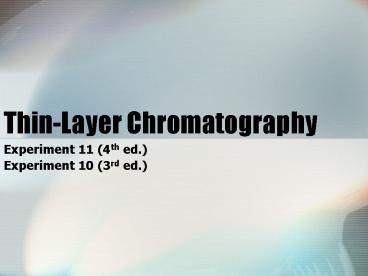ThinLayer Chromatography - PowerPoint PPT Presentation
1 / 13
Title: ThinLayer Chromatography
1
Thin-Layer Chromatography
- Experiment 11 (4th ed.)
- Experiment 10 (3rd ed.)
2
Required Reading Before Class
- 4th ed.Exp. 11
- Sections 1-4 of Techniques 19
- Sections 1, 2, 4, 5, 6, 7, 9, 10 of Technique
20 - 3rd ed.Exp. 10
- Sections 1-4 of Technique 12
- Sections 1, 2, 4, 5, 6, 7, 9, 10 of Technique 14
3
Overview of TLC
- TLCone form of solid-liquid chromatography
- Adsorbentsolid phase it wont dissolve in the
associated liquid phase - Ex Silica Gel (Si02) Alumina (Al2O3)
- Elutentliquid phase
- Solvated substances are spotted onto a TLC plate
coated with the adsorbent and allowed to elute up
the plate by capillary action
4
TLC Development Setup
5
Overview of TLC
- This technique manipulates POLARITY
- More polar substances bind strongly to the
adsorbent and elute SLOWER - Less polar substances bind weakly to the
adsorbent and elute FASTER - The strength of interactions between the
adsorbent and eluting components vary
approximately in this order - Salt formation gt coordination gt H-bonding gt
dipole-dipole gt van der Waals - (More Polar)
(Less Polar)
6
Overview of TLCThe Rf Value
- A given compound will always travel a fixed
distance relative to the distance the solvent
travels - This ratio is called the Rf value and is
calculated in the following manner - . distance traveled by substance . distance
traveled by solvent front
7
TLC Visualization Methods
- Ultraviolet Lightsome organic compounds
illuminate or fluoresce under short-wave UV light - Iodine Vaporforms brown/ yellow complexes with
organic compounds - Fluorescent Indicatorscompounds fluoresce when
placed under UV light - Silver Nitrate Spray (for Alkyl Halides)dark
spots form upon exposure to light - Sulfuric Acid Spray Heatpermanent charred
spots are produced
8
Applications of TLC
- TLC has several important uses in organic
chemistry. Some examples are - To establish that two compounds are identical
- To determine the number of components in a
mixture - To determine the appropriate solvent for a
column-chromatographic separation - To monitor the progress of a reaction
9
Procedural Notes
- TLC Chamber Preparation
- Cut the filter paper so that it fits in the jar,
touching the bottom and reaching a height of
about 1cm from the top of the jar - To ensure that the filter paper will work, put it
in the jar, and then place an unused TLC plate in
the jar. If the above criteria are met and the
plate doesnt make any contact with the filter
paper, the setup should work - Remove the TLC plate, and then completely
saturate the filter paper with the development
solvent using a pasteur pipet. - Fill the jar with development solvent to a depth
no greater than 0.5cm - Put the lid on the jar to preserve the saturated
conditions
10
Procedural Notes
- TLC Plate Preparation
- Do not touch the coated surface of the TLC plate!
It is best to wear gloves when handling, but you
can also manage by just grabbing the plate on the
edges - Using a PENCIL, draw a line across the plate
about 1cm from one end - Label your spotting lanes. You should be able to
get at least three lanes per plate
11
Procedural Notes
- Spotting the TLC Plate
- Dip the open end of a capillary tube into the
solvent containing the compound to be eluted - Touch the end of the capillary tube lightly and
very briefly to the coated surface of the TLC
plate - Your spots should be made on the line drawn
across the plate in the correct lanes and
shouldnt have a diameter much larger than the
capillary tube - After spotting the plate, place it in the
saturated chamber and close the lid - Substances should be eluted until the solvent
front reaches a height of about 0.5cm from the
top of the TLC plate
12
Procedural Notes
- Marking the TLC Plates
- Before allowing the plate to dry, mark the
solvent front w/a pencil - After drying, observe the developed plate under
short-wave UV light. Circle all visible spots
w/a pencil - Perform the I2 vapor visualization method after
doing the UV method
13
Analyses
- Calculate Rf values
- Compare the values of known compounds to the
unknowns interpret the data - Compare the visualization methods used
- Dont forget to sketch your TLC plates for your
lab report. You do not need to turn in your TLC
plates, although you may attach them to your lab
report if you wish.































